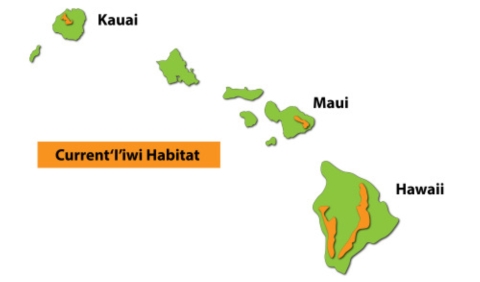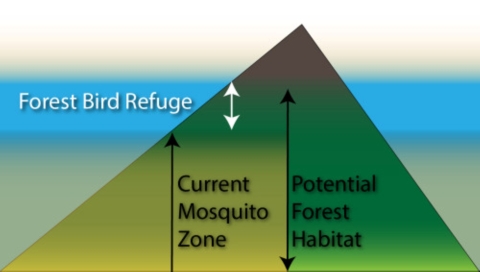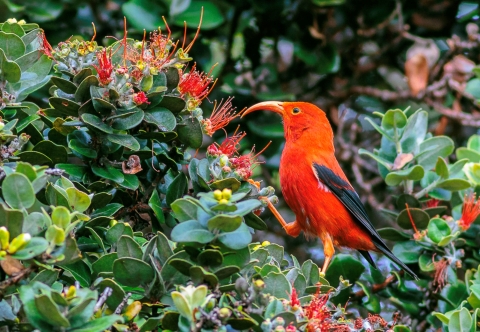This year is the 50th anniversary of the Endangered Species Act, a law that has been a powerful catalyst for conservation of America’s most treasured fish, wildlife, plants and their habitats. In the Pacific Region, our Tribes, state and federal agencies, and partners have joined with our dedicated staff to be the driving force behind the successes we share and the strength ensuring we can address the challenges ahead. Celebrate this milestone with us in this collection of stories as we reflect on past successes, assess current challenges, and envision an equally bright future for the next 50 years and beyond.
Once one of the most common forest birds in the Hawaiian Islands, the ‘i‘iwi, also known as the scarlet honeycreeper, will now be protected as a threatened species under the Endangered Species Act.
In the past, ‘i‘iwi could be found from the coastal lowlands where they foraged for food to the high mountain forests where they nested. Today, ninety percent of the ‘i‘iwi population is confined to a narrow band of forest on East Maui and the windward slopes of the island of Hawaii, between 4,265 and 6,234 feet (1,300 and 1,900 meters) in elevation. The birds are virtually gone from the islands of Lanai, Oahu, Molokai and west Maui, while the population on Kauai is in steep decline.
“In recent years, the ‘i‘iwi population has been in sharp decline, due to threats from habitat loss, invasive species invasive species
An invasive species is any plant or animal that has spread or been introduced into a new area where they are, or could, cause harm to the environment, economy, or human, animal, or plant health. Their unwelcome presence can destroy ecosystems and cost millions of dollars.
Learn more about invasive species and avian diseases, particularly avian malaria,” said Mary Abrams, project leader for the Service’s Pacific Islands Fish and Wildlife Office. “These threats have affected all forest birds, not just the ‘i‘iwi. Conservation that benefits the ‘i‘iwi will undoubtedly benefit other Hawaiian forest birds.”
Avian malaria, carried by invasive mosquitos, is the primary driver in the decline in of the ‘i‘iwi population, and has already caused the decimation of dozens of other Hawaiian forest birds. The disease kills approximately ninety-five percent of infected ‘i‘iwi. Mosquitos, which are not native to the Hawaiian Islands, breed and thrive at lower and warmer elevations where they infect birds like the ‘i’iwi with avian malaria and pox.
“‘I‘iwi have virtually disappeared from any habitat where mosquitoes are found,” said Abrams. “This has caused their range to shrink dramatically – they are almost entirely limited to higher elevation ‘ōhi‘a forests for their habitat, dietary, and nesting needs.
Higher and cooler elevation ‘ōhi‘a forests, where mosquitoes do not thrive, remain the only habitat for the ‘i‘iwi, but even those areas are under threat. As temperatures rise, mosquitoes, and the avian diseases they carry, are able to survive at higher elevations and spread upwards into the mountains, further constricting the ‘i‘iwi’s range.
‘I‘iwi are dependent for their survival on forests of native ‘ōhi‘a. On the island of Hawaii, home to 90 percent of the remaining ‘i‘iwi population, those ‘ōhi‘a forests have been under attack from rapid ‘ōhi‘a death, an invasive tree pathogen.
“Working with the state, our conservation partners and the public will be crucial as we work to recover the ‘i‘iwi, said Abrams. “The Service is committed to building on our record of collaborative conservation to protect Hawaii’s native species.”
The Service’s final listing rule was be published in the Federal Register on Sept 20, 2017, and will became effective on October 20, 2017.
<<This article has been edited to correct the date on which the rule will become effective, which was incorrectly stated as September 20th.>>>
More information about the 'i'iwi
More photos of the ‘i’iwi
Official News Release
Read more stories about issues facing forest birds.
- Hawaii’s Magnificent Forest Bird
- ʻŌhiʻa lehua: The Foundation of Hawaii’s Forest Ecosystem:
- Mysterious Disease Threatens Critical Hawaiian Forests
- What’s Killing Hawaii’s Forest Birds
###
The U.S. Fish and Wildlife Service works with others to conserve, protect, and enhance fish, wildlife, plants, and their habitats for the continuing benefit of the American people. For more information, visit www.fws.gov/pacificislands, or connect with us through any of these social media channels at https://www.facebook.com/PacificIslandsFWS, www.flickr.com/photos/usfwspacific/, https://medium.com/usfwspacificislands or www.twitter.com/USFWSPacific.









